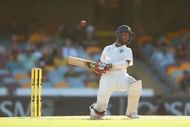
Cheteshwar Pujara's man of the match performance in the first Test against Australia has earned him much acclaim. The number three batsman top-scored in both India's innings to seal a historic win for the visitors.
The performance has also drawn many comparisons between Pujara and Rahul Dravid, whose man of the match performance at the same venue, 15 years ago, similarly saw India take a 1-0 series lead.
Like Dravid, the vast quantity of runs Pujara scores is often overlooked due to him not being as flamboyant as other batsman. But closer inspection at Pujara's role in the Indian Test side shows that his value actually stretches beyond the runs he scores.
This is because with Pujara batting at three, and Virat Kohli batting at four, Pujara often serves as Kohli's protector.
Many of the world's best batsman opt to bat at four. It is the preferred batting position of Steve Smith and Joe Root, while the likes of Sachin Tendulkar, Greg Chappell, Ken Barrington, Javed Miandad, Younis Khan, Brian Lara, Mahela Jayawardene, and Kevin Pietersen also found a great deal of joy batting in this position.
The reason for this is simple, as batting at four ensures a batter will come to the crease relatively early in an innings, but will rarely have to face the new ball. The latter is particularly true if they have a defensively skilled number three ahead of them.
Dravid and Tendulkar are perhaps the best examples of this. Not only did the pair spend a lot of time at the crease together, but Dravid also spent a lot of time in the middle ensuring Tendulkar was protected from the new ball. This is not because of any weakness Tendulkar had towards swing bowling, but because it simply makes sense to have the teams best batter arrive at the crease when runs are easier to come by.
Take Tendulkar's superb 193 in Headingley, for example. In this innings, Virender Sehwag fell early to Matthew Hoggard. Dravid than came to the crease with the ball still swinging, and with skilled bowlers such as Hoggard, Andy Caddick and Andrew Flintoff exploiting that swing.
But along with Sanjay Bangar, Rahul Dravid wore the bowlers down. He and Bangar played fairly conservatively, but by the time Bangar fell, India were on 185. This allowed Tendulkar to come in and play positively, along with Ganguly who also scored a brisk hundred batting at five.
Other number fours have benefited from similarly stubborn number threes. Kevin Pietersen often benefited from having Jonathan Trott batting ahead of him. In fact, for several years England had great success using their top three of Alastair Cook, Andrew Strauss and Jonathan Trott to blunt the new ball and ware down the bowlers, before the likes of Pietersen, Ian Bell, and Matt Prior would come in and play aggressively. This allowed them to capitalize on the tiredness of the bowlers, which had been created by the top-order.
But with India currently struggling to find an effective opening partnership, Pujara's batting is perhaps more important than ever. His ability to remain at the crease through the difficult times, and allow Kohli to come in in more favorable positions, has been crucial to the form of both his captain and his team.
Kohli's most recent Test century, which he scored against the West Indies in October, epitomizes this. In this innings, Lokesh Rahul fell for naught early on. However, along with Prithvi Shaw, Pujara not only ensured he saw off the new ball, but also helped India to a score of 209 before he fell. This meant that Kohli arrived at the crease facing bowlers and a old ball that was no longer swinging, and bowlers who were into their third or fourth spells.
This presents a much more favorable scenario for the Indian captain than if Pujara had been dismissed cheaply, and Kohli had been forced to face the ball as a result.
Kohli may still have succeeded, but the work Pujara did beforehand meant his odds of success were far greater.
The benefits of having a good number three like Pujara are further highlighted by the number of skilled batters who have struggled to bat there.
Joe Root moved up to three against India recently, and while he has found sporadic success in the position, he only averages 40.47 there, compared to 51.14 batting at four, and 73.13 batting at five.
Shivnarine Chanderpaul, despite his sturdy defense, only averaged 34.26 at three. Similarly, Steve Waugh was trialed at three for a short period in the early 90s, but his average of just 36 batting there led him to move back down to the middle order.
Greg Chappell averaged 43.29 at three, which is 10 below his career average, while Inzamam-ul-Haq also struggled greatly at three, averaging just 24.25
Virat Kohli has played six innings at three, and averages just 19.40 in that position.
If he batted at three long term, there is little doubt he would improve upon these numbers. But when it is considered that so many great batsman struggle batting at there, and that so many great batsmen also benefit from being protected by a good number three, it can also be assumed that Kohli is best off at four, with Pujara ahead of him.
Pujara's value to his team is therefore even greater than his impressive average of 50.49 may suggest. His performances at number three not only boost India's top order

but also pave the way for Kohli and the Indian middle-order.
Follow IPL Auction 2025 Live Updates, News & Biddings at Sportskeeda. Get the fastest updates on Mega-Auction and cricket news
